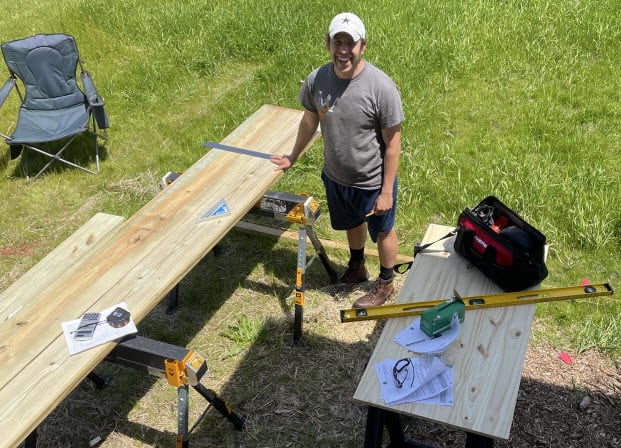Best Of
Community Champion of the Month - August, 2025
The Community Team would like to introduce the August Champion of the Month, Dr. R. B. B. Ovando.
Dr. Ovando is a researcher and engineer working at the intersection of electromagnetism, heat transfer, fluid dynamics, materials (stress, mechanical and physical metallurgy), and numerical simulation. His work combines finite element modeling, experimental validation, and new theoretical approaches to problems in induction heating, electromagnetic fields physics, and energy systems. He actively uses Altair solvers for induction heating and electromagnetic design projects, especially for coupling FEM with custom predictive models and optimization algorithms. He also integrates results from Altair solvers with Python-based AI tools of my own to explore advanced concepts like field effects, predictive thermal analysis, and predictive metallurgy transformations, among others.
“What I enjoy most about Altair products (particularly Flux, SimLab, and HyperWorks) is their ability to bridge theory and practice. I can design, simulate, and validate concepts with high fidelity, which accelerates both innovation and real-world prototyping. The community aspect is equally important: exchanging ideas and solutions with other users always sparks new insights.”
Outside of his professional work, Dr. Ovando enjoys sketching and creating conceptual illustrations, as well as writing about physics and engineering in ways that blend technical rigor with creative storytelling. “I also like applying engineering tools in everyday life (whether it’s using CAD and FEA) to plan home improvement projects, such as decks, or cars repair, which connects back to my background as an automotive technician.”
Please join the Community team to congratulate Dr. R. B. B. Ovando and thank him for sharing his ideas and solutions with other members of the Community.
—————————————————————————————————————————-Is there a fellow Community member you feel deserves to be recognized as next month's Community champion? Let us know who they are and why you feel they exhibit the qualities of a leader by emailing us at at community@Altair .com. You can also learn more about the Community Champion of the Month program here Monthly Community Champion.
Community Quick Tour
Watch a Quick Tour video for a guided experience to understand and navigate the site's features and functionality.
From Steel to Timber - Discover What's Next for AEC
Altair will host our first global ATCx AEC, a one-day virtual event dedicated to transforming the architecture, engineering, and construction (AEC) sector on Wednesday, April 30, 2025.
Following the main session, engage with industry leaders in the Structural Timber Design Track to explore the progressive role of timber in contemporary construction, gaining insights into mass timber applications, hybrid structures, and innovations driven by sustainability.
Featured Presentations:
- State-of-the-art Research at FPInnovations: Advancing Wood Use in Sustainable Construction | Dr. Zhiyong Chen I Senior Scientist, FPInnovations
- Industry Presentation: Cast Connex | Jennifer Pazdon I Vice President, USA and Director, UK Division, Cast Connex
- Workshop and Live Q&A - Hybrid Structural Analysis and Design in Altair® S-TIMBER™ | Moein Ahmadipour I Senior Product Manager AEC, Altair
Configuring GPU for PhysicsAI model training
Configuring GPU for PhysicsAI model training
Hello PhysicsAI users,
As you are already aware that the GPU can be leveraged for model training in PhysicsAI, however, there are a few important points which should be considered to make sure that the GPU gets utilized by PhysicsAI for the same.
First consideration : required software architecture for supporting GPU usage
- Checking CUDA/CUDNN libraries compatibility with PhysicsAI : Make sure that the CUDA Toolkit 11.8 & CUDNN 8.7 version are installed on the machine.
- Kindly refer to the ‘Appendix’ section to check for the download links on the same.
Note: No other versions of CUDA Toolkit are supported as of now due to dependencies of the other HyperWorks products on the CUDA Toolkit 11.8 & CUDNN 8.7 version.
To cross-check, if the Window’s machine has the required CUDA libraries installed, follow the below mentioned steps:
- Checking CUDA Toolkit version: Open Windows Command Line/PowerShell & write the command nvcc --version to get the CUDA version information (as shown in Figure 1).
Note: If one is performing a new installation of CUDA Toolkit 11.8 from the link mentioned in point 2 above, NVIDIA might prompt to install the latest CUDA Version. Kindly install it as it is & verify the version (as shown in Figure 1).

Figure 1 : Checking CUDA Toolkit version using nvcc --version in the Windows PowerShell
Second consideration : required hardware architecture for supporting GPU usage
- Checking GPU compatibility with PhysicsAI: Make sure that the GPU being considered has the correct specifications in terms of the ‘Compute Capability’.
- PhysicsAI supports oldest Compute Capability as 6.0.
- To do so, in HyperMesh under the Python console (View>Python Window), write the below commands to check the GPU specifications & ‘Compute Capability’ (as shown in Figure 2).
from tensorflow.python.client import device_lib
print(device_lib.list_local_devices())

Figure 2 : GPU Specifications & Compute Capability using the Python Window in HyperMesh
FAQ’s related to using GPU in PhysicsAI:
- Checking GPU usage for model training:
- Traditionally, GPU usage (CUDA graphs) can be checked using Windows Task Manager. However, there have been instances of GPU usage (CUDA graphs) not being shown in the Windows Task Manager & hence, the above-mentioned suggestions can serve useful to check if GPU/CPU is being used for the PhysicsAI model training.
- Once GPU has the Compute Capability of greater than 6.0, CUDA Toolkit 11.8 & CUDNN 8.7 version are installed, then PhysicsAI would automatically use the GPU for the model training & the log file under ‘PhysicsAI>Model training>Show Log’ will have the GPU memory usage displayed (as shown in Figure 3) at the end of the training log.

Figure 3 : GPU usage by PhysicsAI for the model training indicated by the ‘Model Training Log’
- Disabling GPU usage for PhysicsAI model training
Once GPU is detected by PhysicsAI, it will automatically be used for the model training. If in certain scenarios, CPU usage is required instead, set the environmental variable as shown below:
CUDA_VISIBLE_DEVICES=-1
This would serve useful in scenarios where the GPU does not have enough memory to train the model due to various reasons related to the number of elements/nodes in the model, model hyper-parameters such as width/depth/epochs & gives the PhysicsAI error as ‘Resources exhausted during training - Try reducing width, depth or size of the mesh’.
- Memory consumption by GPU for the PhysicsAI model training:
- During model training, one training batch is moved from the CPU to GPU at a time. For example: if a batch size of 1 is used, only one model (mesh) resides on the GPU at a time & hence, the peak memory usage is governed by the largest model (mesh) in the training data & not on the number of training meshes in total used for the model training.
- To increase the GPU peak memory usage, the batch size can be increased (as shown in Figure 4) & each epoch would be faster. However, increasing the model size can affect the model accuracy & also might require adjustment of the learning rate when batch size has been increased.
- PhysicsAI 2024.0 version supports mini batch size feature & can be fine-tuned as per the requirement.

Figure 4 : Batch size configuration in PhysicsAI (based on Altair internal content)
Other relevant blogs on PhysicsAI:
To understand other details related to PhysicsAI, kindly refer the blog (13 Frequently Asked Questions About Altair physicsAI) using the below link: https://community.altair.com/community?id=community_blog&sys_id=5e76d67f1b7c7510c4dfdbd9dc4bcba6
Appendix:
Student Edition Licenseの更新について
以下のQ&Aを参考に、Altair oneのmarketplaceにて、Student Edition LicenseをRenewしようとしたところ、OTPは発行されるのですが、ブラウザ(google chrome)上にOTPを入力するpopupが表示されません。ブラウザ側のポップアップブロックを解除した場合も同様でした。
また、ブラウザをMicrosoft Edgeに変更した場合も、同じ状況でした。
どうすればpopupが表示されるようになるか教えてください。
参考Q&A
https://community.altair.com/discussion/61846/how-to-renew-your-altair-one-student-edition-license-key-once-it-expires?utm_source=community-search&utm_medium=organic-search&utm_term=studenet+license+renew
Community Champion of the Month - February, 2025
The Community Team would like to introduce the February Champion of the Month, Jagan Adithya Elango @Jagan .
Jagan is a Design Engineer who is passionate about solving engineering challenges by applying his knowledge of CFD, thermodynamics, fluid mechanics, and heat transfer. He has experience modeling conjugate heat transfer in electric traction motors and controllers, utilizing Altair HyperMesh CFD (pre and post processing) and AcuSolve (solver) to predict and enhance their thermal performance, which is crucial for safe operation and reliability. He is a collaborative team player with strong analytical skills.
In his own words, “What I love about Altair products, especially the CFD tools, is how intuitive and user-friendly they are. They're straightforward to learn and easy to use, making complex simulations more accessible.”
Please join me in congratulating Jagan @Jagan and thanking him for sharing his knowledge and expertise with other members of the Community.
______________________________________________________________________________________________________
Is there a fellow Community member you feel deserves to be recognized as next month's Community champion? Let us know who they are and why you feel they exhibit the qualities of a leader by emailing us at community@altair.com. You can also learn more about the Community Champion of the Month program here Monthly Community Champion.
.
How to model non-linear spring in OptiStruct
Non-linear springs find applications in various industries. These springs exhibit non-linear force-displacement characteristics, making their modelling a crucial aspect of structural analysis. OptiStruct offers a range of element types to simulate complex structures accurately. When dealing with non-linear springs, one possible approach is using the CBUSH element with the PBUSH property and PBUSHT table options to accurately represent the behaviour of these components.
In this article, we will check how to work with such elements and validate the results of modelling a non-linear spring using PBUSH property and PBUSHT in OptiStruct.
Format and Definition
Once the CBUSH element is created and the PBUSH property is assigned to it. Keep in mind that is always necessary to assign the CBUSH element to a local coordinate system through CID field under card edit. If setting CID = 0, the CBUSH will be assigned to the global coordinate system:

Under the K_LINE option in PBUSH property, you will input the stiffness value of the linear spring. This value will not be considered for the non-linear application. In this case, it is always overwritten by the force x deflection curve.
To model a non-linear spring, we need to activate the PBUSHT field and then the KN option, which represents the force versus deflection table for dofs 1 through 6, respectively.
Some important aspects to be considered:
- TYPE=KN is allowed only for nonlinear analysis.
- For TYPE=KN, Tension is U > 0 and Compression is U < 0 where U = U(GB) - U(GA) in CBUSH element coordinate system: GA/GB are grid points on CBUSH.

(Image source: https://www.coursehero.com/study-guides/boundless-physics/hookes-law/)
Example and Validation
As an example, we will use the following model, which can be found in the following link:

The model consists of a plate fixed on one side and an enforced displacement curve will be applied on the other end. The load will compress the plate in the first moment and then tension it. In the middle of the plate, there is a non-linear spring, which we will monitor the force and displacement of it. The load and spring curves are, respectively:

Load Curve

Spring curve
To validate the results, we need to calculate the incremental distance between the spring’s GA and GB and the spring force. With these results, we can access the spring curve and check if they are matching.
For the maximum negative displacement at t=0.25:

And for the maximum positive displacement at t=1.00:

Bringing these values back to the force versus displacement curve, we can validate the PBUSHT results:

Community Champion of the Month - January, 2025
The Community Team would like to introduce the January Champion of the Month, Philip Holland @Philip_Holland.
For 44 years Philip R Holland has been working with the SAS language. In that time, he has witnessed the evolution of usage of the language from mainframes to modern analytics environments used across all business sectors on all major computing platforms.
Philip has advised a broad range of clients in the UK, throughout Europe and the United States as an independent consultant and founder of Holland Numerics Limited, a SAS technical consultancy. A SAS user since 1981, he has worked on SAS applications on all the major computing platforms and has frequently presented papers on a wide range of topics related to SAS at conferences around the globe. He has also published 6 books about SAS programming and is writing more.
Philip is the editor of VIEWS News, the quarterly journal of the VIEWS International SAS Programming Community and has been a VIEWS committee member since 2002. He is a SAS Certified Advanced Programmer, a member of the British Computer Society, and a Chartered Information Technology Practitioner.
Initially his interest in Altair SLC was sparked by the existence of a free Community Edition, which he used to write his book about Altair SLC, and he enjoys using the robust SLC software for SAS programming due to the modern and productive feature set offered through the Altair Analytics Workbench IDE. His SAS programming projects are varied, and he can achieve most programming tasks he needs with SLC quickly and easily. From a personal point of view, he loves solving puzzles, and finding a new programming platform for a programming language he knows so well has fed his puzzling appetite.
Please join me in congratulating Phil @Philip_Holland and thanking him for sharing his expertise with other members of the Community.
______________________________________________________________________________________________________Is there a fellow Community member you feel deserves to be recognized as next month's Community champion? Let us know who they are and why you feel they exhibit the qualities of a leader by emailing us at community@altair.com. You can also learn more about the Community Champion of the Month program here Monthly Community Champion.
This article provides an overview of Response Spectrum Analysis with theory and tutorial.
Response Spectrum Analysis
Introduction
Response Spectrum Analysis (RSA) is a technique used to estimate the maximum response of a structure to a transient event.
The technique combines response spectra for a specified dynamic loading with results of a normal modes analysis.
The attached .pdf discusses the usage of this method.
Architectural changes in Abaqus user profile from HyperMesh 2022
Altair commitments
As a starter, some of the modifications changed the way we write the inp file.
Our choices for the format of the inp file are driven by development decisions, considering not only Abaqus, but also the consistency and the ease of conversion with other solvers supported in HyperMesh.
As Abaqus supports multiple ways for modeling some entities, starting with sets, our internal Q&A process focus on ensuring that the modifications we brought to Abaqus:
- still produces a valid inp file (the inp file runs fine with Abaqus)
- and that the results obtained with the new inp file are the same as for the former one, as soon as both inp are run with the same version of Abaqus.
That said, we do not commit to preserve the ascii structure/organization of the inp file.
Please report to our support team asap if one (or multiple) of your models is not running anymore with Abaqus or returns different results.
In case you authored some automation on Abaqus pre and/or post-processing, please contact us so that we can provide you guidance about how to adjust your automations to consider the new model structure.
What changed?
Please review the video below for having a first glance at the main changes introduced between 2019 and 2022:
 https://www.youtube.com/watch?v=_F5owJKw5r4
https://www.youtube.com/watch?v=_F5owJKw5r4
About the main changes:
Some of the changes shown in the video require some in-depth explanations. The links below explain what changed for some of the entities detailed in the introduction video.




